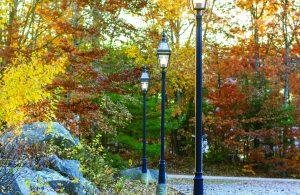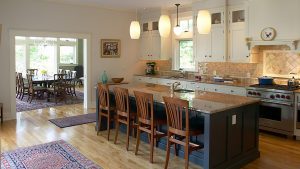Q: What’s a good strategy for lighting a yard?
A: I suggest following a less is more approach. You don’t want your yard to be lit up like a theme park, and I promise your neighbors don’t either. Too much exterior light can be blinding, uses unnecessary electricity, and contributes to the brightening of the night sky, making it difficult to see stars and disrupting animal habitats. Instead, focus on installing fixtures where you need them — near a patio or path, for example — and accentuating a few special features in the landscape. In addition to making your yard feel inviting when you’re outdoors, these pockets of illumination give you something to gaze out at (other than a black window) when you’re inside your home at night.
I recommend down lighting, also known as moonlighting, as an environmentally friendly means of landscape lighting. You can place downlights, which have a cylindrical casing around the bulb to eliminate glare, high up on tree trunks and aim them at a walkway, seating area, or the tree’s own foliage for a moonlit effect. Path lights — typically 18- to 24-inch posts topped with canopies that direct light downward — are a good choice for highlighting plantings in a garden. Modern versions, such as those shown above, are also available. Place path fixtures about 20 feet apart to create glowing areas that draw the eye from one plant to the next versus a single blast of illumination. Avoid stationing these lights at regular intervals along a path, which conjures a landing strip, and using them on lawns, where they are vulnerable to lawnmowers and weed wackers.
Opt for solid brass or copper fixtures, which hold up well in Maine weather and can withstand the occasional ding from a power tool, and use 20-watt equivalent LED bulbs. These last up to 20 years in a landscape setting (compared with six months to a year for halogen bulbs), a lifespan you’ll be especially thankful for if your fixtures are in a tree.






